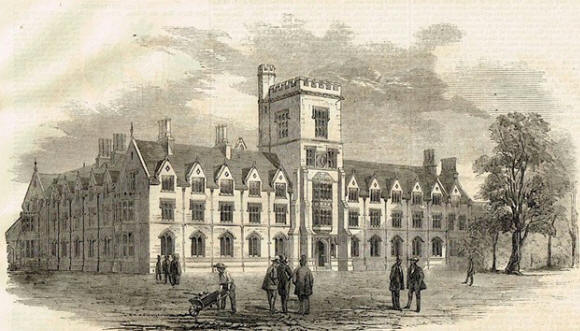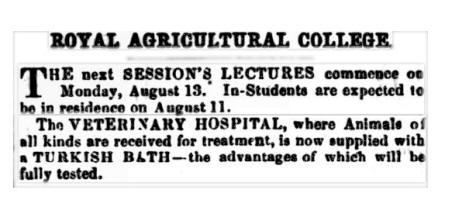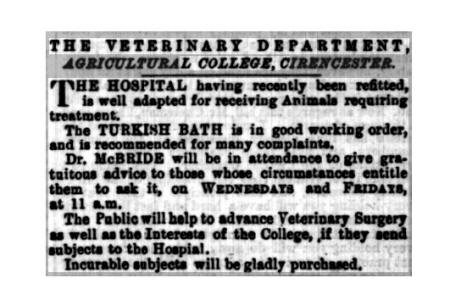Victorian Turkish baths for animals:
Royal Agricultural College, Cirencester

The Royal Agricultural College (now The Royal Agricultural University, a public university in Cirencester) was established in 1845 and was the first agricultural college in the English-speaking world.
It is significant, therefore, that as early as 1850 they had appointed George Thomas Brown as Professor of Veterinary Science. A veterinary hospital had already, or very soon afterwards, been established, and a Turkish bath for animals was installed in 1860.

So almost immediately after Dr Barter's Turkish bath for cattle had been built, the RAC decided to test its use with animals, and indicated that its veterinary hospital was open to receive animals of all kinds from the public.

By the 1870s they were specifically indicating that 'The Public will help advance Veterinary Surgery…if they send [their animals] to the Hospital.'
Given Professor Brown's advocacy of the Turkish bath, it would have certainly contributed to the education of the college's students. For in its 1881 prospectus, the college stated that 'The treatment of the diseases and the surgical operations, etc, are carried on in the presence of the Students, and with their assistance, and each of them keeps a Hospital Journal of all the cases.'
It is not known when the RAC stopped using its Turkish bath, but it was certainly still in use in 1885.1
This page first published 20 November 2023
Peter Brooks Royal Agricultural University, Cirencester, Archivist , for much helpful information
This page enlarges an image or adds to the information found below:
The provision of Turkish baths for animals
Turkish Baths for animals in Victorian London & Middlesex

Victorian Turkish Baths: their origin, development, and gradual decline



Comments and queries are most welcome and can be sent to:
malcolm@victorianturkishbath.org
The right of Malcolm Shifrin to be identified as the author of this work
has been asserted by him
in accordance with the Copyright, Designs and Patents Act 1988
© Malcolm Shifrin, 1991-2023